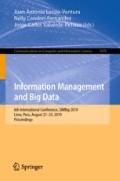Abstract
Nowadays, the mass media surround us in many forms. Newspapers, radio and TV reports about many topics, including the crime committed in a region. Indirectly, the media provide statistics about crime incidents, and policymakers could focus their attention on the unusual number of crime news (c.f., regular events) for evaluating and proposing new public policies. In the present work, the Tensor decomposition is used to detect an unusual amount of crime news. To achieve this goal, two rejection criterion techniques were compared. Also, several image binarization techniques were used to validate our proposal. Our result can be used to detect an unusual amount of crime news as a proxy of unusual crime activity.
Access this chapter
Tax calculation will be finalised at checkout
Purchases are for personal use only
References
Anandkumar, A., Ge, R., Hsu, D., Kakade, S.M., Telgarsky, M.: Tensor decompositions for learning latent variable models. J. Mach. Learn. Res. 15, 2773–2832 (2014). http://jmlr.org/papers/v15/anandkumar14b.html
Chen, H., Chung, W., Xu, J.J., Wang, G., Qin, Y., Chau, M.: Crime data mining: a general framework and some examples. Computer 37(4), 50–56 (2004)
Dani, M.-C., Jollois, F.-X., Nadif, M., Freixo, C.: Adaptive threshold for anomaly detection using time series segmentation. In: Arik, S., Huang, T., Lai, W.K., Liu, Q. (eds.) ICONIP 2015. LNCS, vol. 9491, pp. 82–89. Springer, Cham (2015). https://doi.org/10.1007/978-3-319-26555-1_10
Fanaee-T, H., Gama, J.: Tensor-based anomaly detection: an interdisciplinary survey. Knowl.-Based Syst. 98, 130–147 (2016)
Gupta, M., Gao, J., Aggarwal, C.C., Han, J.: Outlier detection for temporal data: a survey. IEEE Trans. Knowl. Data Eng. 26(9), 2250–2267 (2014)
Hassani, H., Huang, X., Silva, E.S., Ghodsi, M.: A review of data mining applications in crime. Stat. Anal. Data Mining: ASA Data Sci. J. 9(3), 139–154 (2016)
Hayashi, K., et al.: Exponential family tensor factorization for missing-values prediction and anomaly detection. In: 2010 IEEE International Conference on Data Mining, pp. 216–225, December 2010
Kolda, T.G., Sun, J.: Scalable tensor decompositions for multi-aspect data mining. In: 2008 Eighth IEEE International Conference on Data Mining, pp. 363–372, December 2008
Leys, C., Ley, C., Klein, O., Bernard, P., Licata, L.: Detecting outliers: do not use standard deviation around the mean, use absolute deviation around the median. J. Exp. Soc. Psychol. 49(4), 764–766 (2013)
Molina-González, M.D., Martínez-Cámara, E., Martín-Valdivia, M.T., Perea-Ortega, J.M.: Semantic orientation for polarity classification in Spanish reviews. Expert Syst. Appl. 40(18), 7250–7257 (2013)
Mu, Y., Ding, W., Morabito, M., Tao, D.: Empirical discriminative tensor analysis for crime forecasting. In: Xiong, H., Lee, W.B. (eds.) KSEM 2011. LNCS (LNAI), vol. 7091, pp. 293–304. Springer, Heidelberg (2011). https://doi.org/10.1007/978-3-642-25975-3_26
Otsu, N.: A threshold selection method from gray-level histograms. IEEE Trans. Syst. Man Cybern. 9(1), 62–66 (1979)
Perez-Rosas, V., Banea, C., Mihalcea, R.: Learning sentiment lexicons in Spanish. In: LREC, vol. 12, p. 73 (2012)
Sahoo, P., Soltani, S., Wong, A.: A survey of thresholding techniques. Comput. Vis. Graph. Image Process. 41(2), 233–260 (1988). http://www.sciencedirect.com/science/article/pii/0734189X88900229
Sapienza, A., Panisson, A., Wu, J., Gauvin, L., Cattuto, C.: Detecting anomalies in time-varying networks using tensor decomposition. In: 2015 IEEE International Conference on Data Mining Workshop (ICDMW), pp. 516–523. IEEE (2015)
Sidorov, G., et al.: Empirical study of machine learning based approach for opinion mining in tweets. In: Batyrshin, I., González Mendoza, M. (eds.) MICAI 2012. LNCS (LNAI), vol. 7629, pp. 1–14. Springer, Heidelberg (2013). https://doi.org/10.1007/978-3-642-37807-2_1
Takeuchi, K., Tomioka, R., Ishiguro, K., Kimura, A., Sawada, H.: Non-negative multiple tensor factorization. In: 2013 IEEE 13th International Conference on Data Mining, pp. 1199–1204, December 2013
Urizar, X.S., Roncal, I.S.V.: Elhuyar at TASS 2013. de TASS (2013)
Author information
Authors and Affiliations
Corresponding author
Editor information
Editors and Affiliations
Rights and permissions
Copyright information
© 2020 Springer Nature Switzerland AG
About this paper
Cite this paper
Alatrista-Salas, H., Lavado, P., Morzan, J., Nuñez-del-Prado, M., Yamada, G. (2020). Detecting Anomalies in Time-Varying Media Crime News Using Tensor Decomposition. In: Lossio-Ventura, J.A., Condori-Fernandez, N., Valverde-Rebaza, J.C. (eds) Information Management and Big Data. SIMBig 2019. Communications in Computer and Information Science, vol 1070. Springer, Cham. https://doi.org/10.1007/978-3-030-46140-9_4
Download citation
DOI: https://doi.org/10.1007/978-3-030-46140-9_4
Published:
Publisher Name: Springer, Cham
Print ISBN: 978-3-030-46139-3
Online ISBN: 978-3-030-46140-9
eBook Packages: Computer ScienceComputer Science (R0)

